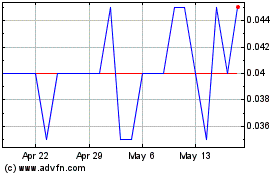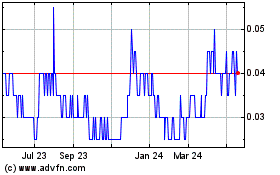Klondike Silver Corp.: Test Mining at the 4755 Level of the Silvana Mine to Provide Mill Feed
June 03 2009 - 1:00PM
Marketwired Canada
Klondike Silver Corp. (TSX VENTURE:KS) (the 'Company') is pleased to announce
that a program of underground rehabilitation and subsequent test-mining is under
way on the 4755 Level of the Silvana Mine in the historic Sandon Silver Camp of
south-central British Columbia.
The Company is the largest landholder in the Slocan Camp, which has produced
more than 24 million ounces of silver plus by-product base metals since the late
1800s. The land package includes ten historic mines and a fully permitted
100-tonne-per-day mill.
At the Silvana Mine, Company personnel have identified several small but
potentially economically mineable areas beyond the limits of productive former
stopes developed in the early 1970s. These areas lie roughly 100 feet (30
metres) or more in elevation above the main 4625 Level adit access. Detailed
re-examination of historic records, including assays from diamond drill holes
and chip/channel samples, show the possibility of mineralized areas amenable to
small-scale mining using best-practice grade control to achieve desired economic
returns.
The work program now under way includes replacing a timbered ore-chute on 4625
Level at the base of the gravity muck pass from 4755 Level, rehabilitating the
skipway and manway between the two levels, re-establishing compressed air, water
and electrical services and bringing mining equipment up to 4755 Level.
Initial test-mining will be by sub-drifting in the Main Lode structure towards
the identified areas of interest. Channel and muck sampling will be carried out
to identify the best sections for stoping. The muck from the development will be
evaluated and stockpiled as appropriate.
The mill run of economic-grade material from test-mining at Silvana will follow
the completion of processing of millfeed from the Company's Stump Property
(Yukon Territory).
The Main Lode structure - the principal source of the Slocan Camp's
silver-lead-zinc production - is more than 5 miles (8 km) long, extending from
Silverton on Slocan Lake in the west to Sandon in the east through the 'Silver
Ridge' of the Selkirk Mountains, 30 miles (50 km) north of Nelson, BC.
The Silvana production was from a length of less than one mile (1.5 km) of the
Main Lode under Silver Ridge, westerly from the Silversmith Mine, a former major
producer near Sandon. The Company holds approximately 1.5 km of the ground to
the west of this productive zone, to within a quarter of a mile (0.5 km) of the
Mammoth Mine.
About 1.5 million tons of ore was locally processed or direct-shipped from these
historic operations. Total recovered production to 1964 from the western segment
was 9.5 million ounces of silver, 45,000 tons of lead and 60,000 tons of zinc.
The eastern segment yielded approximately 9 million ounces of silver, 43,000
tons of lead and 13,000 tons of zinc. The eastern segment was the first area
developed and mined, and as a result less zinc was recovered from processing,
likely because the metal was less sought after or was difficult to recover using
technology available at the time.
Almost all of this recovered production came from a zone within the Main Lode
lying roughly between 4,000 feet (1,200 m) and 5,500 feet (1,700 m) elevation.
The central unexplored portion of this prospective deep zone passes for 2.5
miles (4 km) beneath the 5,000 (1,500 m) to nearly 8,000 feet (2,400 m)
approximate elevations of steep-sided Silver Ridge. This area received initial
underground exploration westerly from the Silversmith Mine area in the late
1940s by the Kelowna Exploration Company using a program of lateral drift mining
and diamond drilling.
A similar but extensive program was conducted westwards from the Kelowna work by
the "Silmonac Syndicate" in late 1962. The Syndicate's persistence was rewarded
in 1967 with the discovery from underground diamond drilling of a
silver-lead-zinc mineralized section of the Main Lode (not recognized
definitively as such at the time).
This section was explored, developed and mined by Silmonac's successors,
including Kam-Kotia Mines Limited, Silvana Mines Inc., Dickenson Mines Limited
and Treminco Resources Ltd. almost continuously from 1970 to 1993, and now by
Klondike Silver. Production to date is about 8 million ounces of silver and over
30,000 tons each of lead and zinc from some 550,000 tons of mill feed,
representing 30% of the area's silver and 25% of its lead production. This makes
the Silmonac/ Silvana operation the second largest single producer of silver and
lead in the Slocan camp after the Standard Mine. It should be noted that the
silver-to-lead ratio from Silvana production was higher than production from the
Standard Mine, an enhancement that improves the potential economics of Silvana's
typical mill feed.
The technical information in this news release has been prepared in accordance
with Canadian regulatory requirements set out in National Instrument 43-101. Mr.
Edward Craft, P.Eng., is designated as the qualified person who reviewed and
approved the contents of this press release.
About Klondike Silver
Klondike Silver Corp. has assembled a quality portfolio of silver and
silver-rich poly-metallic properties in historic mineral districts in North
America, and is applying advanced exploration technologies to add value to these
core assets. Klondike Silver is reviving the Gowganda and Elk Lake silver camps
in Ontario, and the world-famous Klondike district of Yukon Territory. The
Company owns a 100 TPD fully operational flotation mill in Sandon, BC, which is
currently processing material from one of its Yukon properties and local mines
in the historic Slocan Silver Camp.
The statements made in this news release may contain forward-looking statements
that may involve a number of risks and uncertainties. Actual events or results
could differ materially from the Company's expectations and projections.
Klondike Silver (TSXV:KS)
Historical Stock Chart
From Jun 2024 to Jul 2024

Klondike Silver (TSXV:KS)
Historical Stock Chart
From Jul 2023 to Jul 2024
